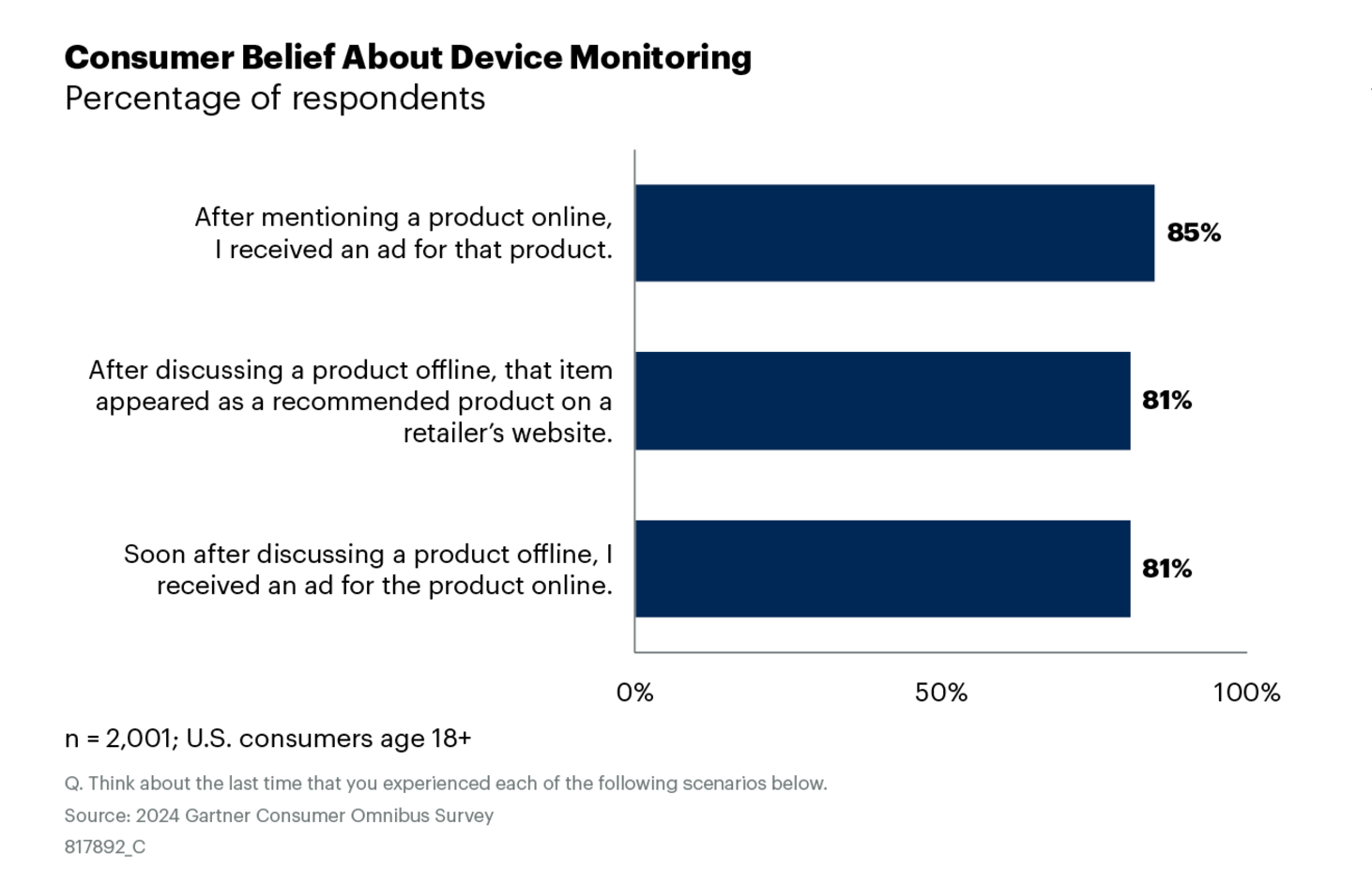The double-edged sword of personalization: balancing relevance and intrusiveness

This article was co-written with Mike FroggattSenior Director, Analyst, at Gartner.
Digital personalization is a double-edged sword. While it can significantly improve the customer experience, it also risks alienating consumers if not executed thoughtfully. Digital Marketing Leaders must carefully manage the reality and perceptions around personalization.
A Gartner consumer survey of 2,001 people in April and May 2024 found that 63% agree that brands are good at guessing what might interest them, indicating progress in personalization efforts . The integration of generative AI technologies is poised to further refine these strategies by enabling more nuanced audience targeting and personalized customer journeys.
Encouragingly, 75% of consumers say they are more positive or neutral about brands after receiving personalized recommendations online. This suggests that consumers expect a certain degree of personalization in their digital interactions. But differences in attitude exist. For example, more baby boomers (47%) experienced a negative reaction when they received a product advertisement after discussing or mentioning a product or brand online than younger generations. This highlights the need for marketers to tailor their strategies to different demographics.
The challenge of perceived intrusion
Although device makers and media companies have long refuted the idea that devices and apps listen to consumers, consumers don’t necessarily believe it. As this chart shows, 81% say that after discussing a product offline, they received either an ad for the product online or a recommendation for the product on a retailer’s website.


In reality, consumers receive product recommendations and retargeted ads due to several factors, including smart speaker interactions and purchase histories. This contributes to the perception that devices and apps monitor consumers’ offline audio conversations. It can erode consumer confidence and highlights why digital marketers should take a cautious approach to serving overly personalized ads and recommendations.
The use of voice assistants for consumer profiling may also raise legitimate data privacy concerns. Many consumers are unaware of the specific data points used for ad targeting, highlighting the importance of transparency in data collection practices.
Dig Deeper: AI is poised to shake up the world of Martech providers and users
To better align advertising strategies with consumer expectations, marketers should consider the following recommendations:
Improve transparency: Communicate how and why consumer data is used in product recommendations and retargeted ads. Transparency builds trust and can differentiate your brand in a crowded marketplace.
Adapting to privacy regulations: Stay ahead of evolving privacy regulations by assessing your organization’s data collection practices and readiness. Bridging the gap between marketing and advertising technology is crucial for seamless integration and compliance.
Leverage first-party data: Expand the use of first-party data for targeting, reducing reliance on cookies and mitigating associated liabilities. Collaborate with key adtech and media partners to maximize the effectiveness of your campaigns.
Study ad targeting technologies: Stay informed about how ad tech companies are using consumer signals to deliver personalized ads. This can help you refine your targeting strategies and improve the consumer experience.
Safeguard brand reputation
Nearly half of consumers (49%) develop a negative view of a brand when its ads appear alongside offensive content. Despite investments in brand safety technologies, challenges persist in ensuring that advertisements are placed in appropriate contexts.
Repetitive video and audio ads also frustrate consumers, with 47% expressing negative feelings towards brands employing such tactics. Leveraging programmatic buying for connected TV (CTV) and digital audio advertising can help offset repetition by enabling better frequency capping and campaign optimization across multiple streaming platforms.
To maintain a positive brand image, consider these strategies:
Use secure sites and allowlists: Start with known safe sites and collaborate with adtech partners to achieve audience scale. Use allowlists and denylists wisely to manage ad placements effectively.
Engage in private markets: Leverage Private Marketplaces (PMP) and Programmatic Guaranteed (PG) inventory for more controlled ad placements. Use selected purchasing partners and measurement and verification tools to ensure quality prints.
Contextual targeting: Work with providers who can target specific content types or block unwanted content. Ensure agreements include provisions for quality assurance.
Brand Impersonation Threats
Brand impersonation, including spoofing attacks, poses significant risks to consumer trust.
Executives should implement social media monitoring tools to detect and combat brand impersonation and collaborate with communications and legal teams to formulate a robust response strategy. Additionally, they should proactively share how customer data is used to improve ads and digital experiences to improve the organization’s trustworthiness, credibility and transparency.
Digital marketers must strike a delicate balance between personalization and consumer trust. Organizations can build lasting relationships with their audiences in an increasingly digital world by aligning advertising practices with consumer preferences and preserving brand reputation.
Contributing authors are invited to create content for MarTech and are chosen for their expertise and contribution to the MarTech community. Our contributors work under the supervision of the writing and contributions are checked for quality and relevance to our readers. The opinions they express are their own.



